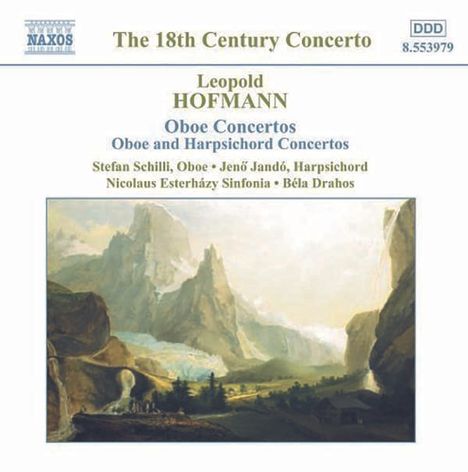Leopold Hofmann: Oboenkonzerte C-Dur & G-Dur auf CD
Oboenkonzerte C-Dur & G-Dur
Herkömmliche CD, die mit allen CD-Playern und Computerlaufwerken, aber auch mit den meisten SACD- oder Multiplayern abspielbar ist.
Lassen Sie sich über unseren eCourier benachrichtigen, falls das Produkt bestellt werden kann.
+Konzerte C-Dur & F-Dur für Oboe, Cembalo, Orchester
- Künstler:
- Stefan Schilli, Jenö Jando, Nicolaus Esterhazy Sinfonia, Bela Dahos
- Label:
- Naxos
- Aufnahmejahr ca.:
- 1999
- UPC/EAN:
- 0730099497923
- Erscheinungstermin:
- 26.8.2002
- Serie:
- Naxos 18th Century Classics
Ähnliche Artikel
In Form und Stil sind Hofmanns Oboenkonzerte von seinen Flötenkonzerten nicht zu unterscheiden, die wiederum eine starke familiäre Ähnlichkeit mit seinen anderen Werken dieser Gattung aufweisen. Hofmanns Konzerte zeichnen sich durch ihre gut durchdachten musikalischen Strukturen, attraktive melodische Ideen und eine höchst idiomatische Soloinstrumentation aus. Selbst dort, wo die Soloinstrumente austauschbar sind, wie im Fall der Flöten-/Oboe-Konzerte, verleiht die Schreibweise den Werken eine ganz besondere Qualität. Die Flöte scheint besonders gut zu Hofmanns musikalischer Sprache zu passen, und vielleicht ist seine Faszination für dieses Instrument ein Beweis dafür, dass er selbst diese Tatsache erkannt hat. Die Hauptstärken des Instruments sind Beweglichkeit und Feinheit der Klangfarbe; es ist in der Lage, flirrende Läufe, schnelle Passagen und die zarte, filigrane Ornamentik auszuführen, die ein so wesentlicher Bestandteil von Hofmanns Konzertstil ist. Wenn aber auf der Oboe die gleichen oder sehr ähnlich konzipierte Passagen gespielt werden, sind sie ebenso wirkungsvoll und doch von außerordentlichem Charakter. In den "authentischen" Oboenkonzerten und in den beiden Doppelkonzerten verleiht die robustere Klangfülle und Durchdringung des Instruments Bravourpassagen und eine expressive Intensität in den langsamen Sätzen, zu denen die Flöte einfach nicht in der Lage ist.
Zu Hofmanns interessantesten und markantesten Orchesterwerken gehören die beiden Konzerte für Oboe und Cembalo, die aller Wahrscheinlichkeit nach in den späten 1760er Jahren entstanden sind. Das Erscheinen der beiden Werke in aufeinander folgenden Jahren im Breitkopf-Katalog (C1 in 1770 und F1 in 1771) ist ein Beweis dafür, dass sie nicht zur gleichen Zeit komponiert wurden. Die ungewöhnliche Kombination von Soloinstrumenten deutet stark auf einen externen Auftrag hin, die Komposition eines zweiten Werkes, vielleicht ein Beweis dafür, dass das erste Werk gut aufgenommen wurde. Die beiden Konzerte stehen in einem sehr starken Kontrast zueinander.
Product Information
In form and style Hofmann’s oboe concertos are indistinguishable from his flute concertos, which in turn bear a strong familial resemblance to his other works in the genre. Hofmann’s concertos are characterized by their well-wrought musical structures, attractive melodic ideas and highly idiomatic solo writing. Even in instances where the solo instruments are interchangeable, as in the case with the flute / oboe concertos, the writing lends the works a very distinctive quality. The flute seems particularly well suited to Hofmann’s musical language and perhaps his fascination with the instrument is evidence that he himself recognised this fact. The instrument’s principal strengths are agility and delicacy of tone colour; it is capable of executing shimmering runs, fast passage work and the delicate, filigree ornamentation which is such an integral part of Hofmann’s concerto style. When the very same passages are played on the oboe, however, or passages very similar in conception, they are equally effective and yet extraordinarily different in character. In the ‘authentic’ oboe concertos and in the two double concertos the instrument’s more robust sonority and penetration lends an edge to bravura passages and an expressive intensity in the slow movements of which the flute is simply not capable.
Among Hofmann’s most interesting and distinctive orchestral works are the two concertos for oboe and harpsichord written, in all likelihood, during the late 1760s. The appearance of the two works in successive years in the Breitkopf Catalogue (C1 in 1770 and F1 in 1771) is evidence of a sort that they were not composed at the same time. The unusual combination of solo instruments points strongly to an external commission, the composition of a second work, proof perhaps that the first work was well received. The two concertos are very strongly contrasted.
Disk 1 von 1 (CD)
-
1 Oboe Concerto in C major (Badley C2): Allegro - Maestoso
-
2 Oboe Concerto in C major (Badley C2): Adagio
-
3 Oboe Concerto in C major (Badley C2): Allegro (non) molto
-
4 Concerto for Oboe and Harpsichord in F major (Badley F1): Spiritoso
-
5 Concerto for Oboe and Harpsichord in F major (Badley F1): Adagio cantabile
-
6 Concerto for Oboe and Harpsichord in F major (Badley F1): Tempo di Minuetto
-
7 Concerto for Oboe and Harpsichord in C major (Badley C1): Tempo di Giusto
-
8 Concerto for Oboe and Harpsichord in C major (Badley C1): Adagio molto
-
9 Concerto for Oboe and Harpsichord in C major (Badley C1): Thema - Menuet (con Variazioni)
-
10 Oboe Concerto in G major (Badley G1): Allegro spiritoso
-
11 Oboe Concerto in G major (Badley G1): Adagio
-
12 Oboe Concerto in G major (Badley G1): Allegro vivace
Mehr von Leopold Hofmann
-
Leopold HofmannFlötenkonzert D-Dur (Badley D1)CDVorheriger Preis EUR 19,99, reduziert um 0%Aktueller Preis: EUR 5,99
-
Sol Gabetta - Hofmann/Haydn/MozartCDAktueller Preis: EUR 7,99
-
Robin Blaze - German 17th Century Church MusicCDVorheriger Preis EUR 19,99, reduziert um 0%Aktueller Preis: EUR 6,99
-
Hans Rosbaud dirigiert Haydn7 CDsVorheriger Preis EUR 39,99, reduziert um 0%Aktueller Preis: EUR 20,99








